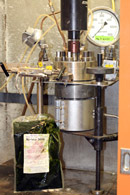
From the first Earth Day to the awarding of the Nobel Peace Prize to Al Gore, Stantec professionals outline the movement's progress.
EPA, DOE, and the Center for Resource Solutions are sponsoring competitive awards that recognize commitment and achievements in green power.
The researchers compared energy use of a conventionally managed corn and soybean system with two low-input systems that used more diverse crops and manure applications.
The Texas Commission on Environmental Quality has $12 million in grants available; the deadline for application is June 30.

Research by National Science Foundation award winner Peter Sunderland may help engine designers improve the way fuel is injected and burned.
By combining conducting and nonconducting domains in the membrane’s nanostructured assembly, researchers improved conductivity performance.
Oil from the offshore well reached Louisiana coastal areas today. The state's governor, Bobby Jindal, declared a state of emergency on Thursday and asked the Defense Department to send up to 6,000 troops to aid in the cleanup.
EPA hosts first national building competition to improve energy efficiency

The $2-million American Recovery and Reinvestment Act-funded research combines hydrothermal, catalytic, and biological approaches to make biofuel.
Phase 1 of process includes the removal of several facilities, lagoon areas, and contaminated soils.
Using renewable energy certificates and power purchase agreements, the company uses energy from the sun, wind, and water flow to power its operations.
A Pacific Northwest storm system may pull the oil toward Louisiana, Alabama, Mississippi and Florida coasts.
University of Massachusetts and University of Minnesota researchers used methane and carbon dioxide in a single reactor to lower greenhouse gases and make more fuel.
Red dye from purple pokeberries help trap more sunlight in fiber-based solar cells.
Scientists call for more risk-based facility design, improved prevention, and response planning.
Five years after achieving LEED certification, the Fannie Mae facility preserves nearly 13,000 gallons of water per day from consumption and waste.
The North Shore-Long Island Jewish Health System has agreed to join EPA programs that will help lower energy and water usage, waste, and air pollution at 12 areas hospitals.
Nuclear engineer Arnold Gundersen says corrosion turns “passive” emergency feature into greater accident risk.
The Princeton Review and the U.S. Green Building Council surveyed hundreds of colleges to find those with commitments to sustainability.
To celebrate Earth Day's 40th birthday, student travel writers have compiled some of their favorite eco-friendly ideas to help travelers reduce their environmental impact.